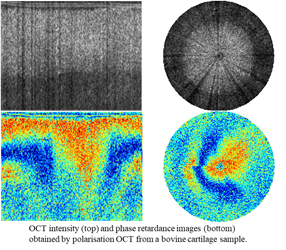Researchers in C-LaSS are pursuing a low-cost polarisation-sensitive optical coherence tomography, in order for patients to access treatment more accessibly.
Researchers
- Vivek Indramohan
- Bisola Mutingwende
- Viji Ahanath
- George Oguntala
Research background
Optical coherencetomography (OCT) is currently recognised as the gold standard for identifying structural retinal abnormalities in ophthalmology.
Due to its ability to acquire fast, highly sensitive in vivo cross-sectional images of the histologic layers of the retina, OCT is an excellent screening tool to use to detect retinal pathology.
As a functional extension of OCT, polarisation-sensitive OCT (PS-OCT) can improve the image contrast of OCT by imaging birefringence of ocular fibrous tissues and has been used to segment and observe retinal pigment epitheliums along with some unique feature of retinal diseases.
However, the cost of clinical PS-OCT systems (up to £80,000) has limited access to this technology to mostly large eye centres and laboratories in the developed world.
We will choose and integrate the latest cost reduction approaches developed for OCT technology to pursue a low-cost PS-OCT system to increase patient access, particularly in low-cost settings.
Research aims
 Our main goal is to design and implement a low-cost, portable PS-OCT system for point of care use with imaging capacities that could meet the required performance for retinal imaging in clinical and laboratory studies.
Our main goal is to design and implement a low-cost, portable PS-OCT system for point of care use with imaging capacities that could meet the required performance for retinal imaging in clinical and laboratory studies.
At the end of the project, we aim to have validated the birefringence measurements of the system by using a well-defined birefringent sample as a test target. We will also have demonstrated the system imaging capacities by comparing with a well-developed clinical PS-OCT system.
How will the research be carried out?
To achieve our project aims our approach is to make use of a low-cost commercial OCT system. Our aim in using a commercial system is to leverage over 2 man-years of development by the commercial company and so accelerate our own programme.
However, the commercial system is not polarisation-sensitive and so we must adapt it, using the experience we have gained from building PS-OCT systems.
Intended outcomes and impact
The imaging system to be produced as an outcome of this research will be a new product, which will fulfil the need within the polarisation OCT market, especially in under developing countries.
